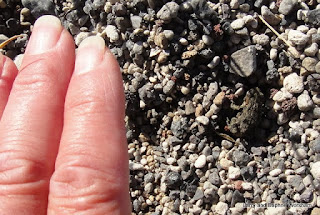The geology of the area is not only amazing, it's unique. Nowhere else will you find mountains of obsidian, lava casts of ancient trees, lakes with warm springs bubbling at the edges, and a waterfall to top it all off. There are nice hiking trails leading to all these features, so you can take a new hike everyday. It's hard to really grasp the magnitude of the area without some degree of elevation.

Our first chance for that type of view was a ranger guided hike up the Big Obsidian flow.
The half mile hike is steep in places, and the trail is pure volcanic glass (obsidian and pumice). Those who showed up in stylish little sandals had a bit of a rough time of it, but it's definitely worth the effort.
Ranger Ashley showed the group a selection of modern arrowheads and blades made from several types of obsidian. This formation is black, but obsidian does occur in other colors, depending on the mineral content.
From the top of the trail you can see Lost Lake and view the rivers of obsidian than make up the flow. The obsidian looks in many places like ropes of taffy, frozen in place, and in others looks like frothy peanut brittle, still others are pure clear glass-like material, the kind the arrowheads are made of. The solid glass-like obsidian is actually fairly rare and so was valuable trading material for the Native Americans in the area. Obsidian from this flow can be traced, through mineral analysis, to tools made by tribes all over the country.
 |
| Paulina Lake on the left, East Lake on the right |
From the peak we could see the surround volcanic plain, with small cone shaped mounds, all covered with dense forest that at this altitude (nearly 8,000 feet) looks like dark green velvet. Smoke from the forest fire near Bend drifted low between the hills in the distance and although it clouded the view somewhat it also lent some definition to the dark, forest covered hills. Far in the distance we could see Mt. Bachelor and The Three Sisters, all snow capped volcanic peaks.
There actually isn't as much wildlife around the campground as I would have expected. A few birds, lots of chipmunks and golden mantle squirrels, and frogs. Tiny little tree frogs no bigger than half an inch. In the photo, the frog, looking much like the gravel, is 2/3 of the way to the right of my hand. They come in green too, but I couldn't get any of them to pose for me!
They're all over the damp shores of the lake, and according to the ranger we talked to, they were all over the floor of the visitor's center when they opened it up for the season.
It seems that every year these little guys decide suddenly in late summer, in one mass migration, to climb the Big Obsidian flow. Perhaps to find a nice winter hiding place in the crevices? No one seems to know for sure why they do it, but it's an annual ritual for them.
We took a drive around both lakes to check out a few of the eight campgrounds, and decided we like ours the best. We're staying in Cinder Hill campground. With 109 sites it's by far the largest campground. There are several sites with lake views, but those were all reserved by the time we decided to stay here. Our site is on the back side of the loop, with a view of the bright red cinder hill up on the side of the caldera. Surrounded by mature Lodgepole pines and dense stands of seedlings, the sites are private and lush.
We checked out Little Crater campground at Paulina Lake (51 spaces) too. It's long and narrow, laid out along the shore of the lake. Lots of nice lake views, but the spaces are wide open (little shade) and packed in pretty close to one another. It would be nice if there aren't many sites occupied, but on this long weekend it's a little too busy for our taste. Paulina Lake campground (71 spaces) has more trees, but is located right next to the highway so there's a lot of road noise to deal with. These campgrounds all take reservations for some of the spaces, but also keep a percentage of the spaces available for drive-in registrants.
Other than a couple of nights that dipped below freezing the weather was beautifully clear and warm. The elevation, and the rim of the caldera, have held back the smoke from the fires north of us, so the sky is that brilliant blue that you usually only see on magazine covers. You can tell fall is on the way - a certain crispness in the air, a few leaves turning color, and the rodents "stocking up", until they are as fat as little baseballs.
For us, autumn means football..... so it's off to Eugene and a couple of Duck games!
Check out the album for additional views of this beautiful area.




No comments:
Post a Comment